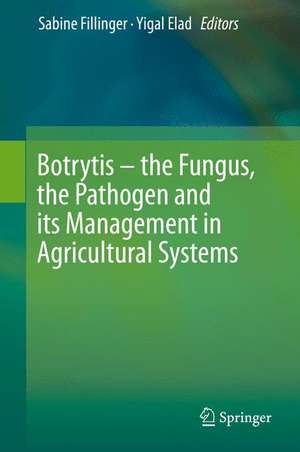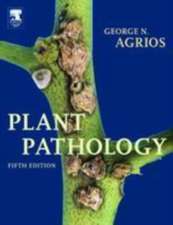Botrytis – the Fungus, the Pathogen and its Management in Agricultural Systems
Editat de Sabine Fillinger, Yigal Eladen Limba Engleză Hardback – 4 ian 2016
| Toate formatele și edițiile | Preț | Express |
|---|---|---|
| Paperback (1) | 825.34 lei 38-44 zile | |
| Springer International Publishing – 30 mar 2018 | 825.34 lei 38-44 zile | |
| Hardback (1) | 1403.67 lei 3-5 săpt. | |
| Springer International Publishing – 4 ian 2016 | 1403.67 lei 3-5 săpt. |
Preț: 1403.67 lei
Preț vechi: 1711.79 lei
-18% Nou
Puncte Express: 2106
Preț estimativ în valută:
268.62€ • 278.85$ • 223.99£
268.62€ • 278.85$ • 223.99£
Carte disponibilă
Livrare economică 01-15 martie
Preluare comenzi: 021 569.72.76
Specificații
ISBN-13: 9783319233703
ISBN-10: 331923370X
Pagini: 400
Ilustrații: X, 486 p. 52 illus., 32 illus. in color.
Dimensiuni: 155 x 235 x 32 mm
Greutate: 1.09 kg
Ediția:1st ed. 2016
Editura: Springer International Publishing
Colecția Springer
Locul publicării:Cham, Switzerland
ISBN-10: 331923370X
Pagini: 400
Ilustrații: X, 486 p. 52 illus., 32 illus. in color.
Dimensiuni: 155 x 235 x 32 mm
Greutate: 1.09 kg
Ediția:1st ed. 2016
Editura: Springer International Publishing
Colecția Springer
Locul publicării:Cham, Switzerland
Public țintă
ResearchCuprins
1 - Botrytis, the good, the bad & the ugly.- 2 - Botrytis-biology, detection and quantification.- 3 - Genetics of Botrytis cinerea.- 4 - Vegetative incompatibility in Botrytis.- 5 - RNA Mycoviruses and Their Role in Botrytis Biology.- 6 - Diversity within and between species of Botrytis.- 7 - Epidemiology and aerobiology of Botrytis spp..- 8 - Cultural and integrated control of Botrytis spp..- 9 - Biological control and biopesticide suppression of Botrytis-incited diseases.- 10 – Chemical control and resistance management of Botrytis diseases.- 11 - Control strategies for postharvest grey mould on fruit crops.- 12 - Infection process and fungal virulence factors.- 13- Signal transduction cascades regulating differentiation and virulence in Botrytis cinerea.- 14 - Reactive oxygen species in the Botrytis – host interaction.- 15 - Secondary metabolism in Botrytis cinerea: Combining genomic and metabolomic approaches.- 16 - Contribution of proteomics research to understanding Botrytis biology
and pathogenicity.- 17 - Overview of plant defence systems: lessons from Arabidopsis-Botrytis cinerea systems biology.- 18 - Hitting the wall: Plant cell walls during Botrytis cinerea infections.- 19 - Ripening of tomato fruit and susceptibility to Botrytis cinerea.- 20 - Plant hosts of Botrytis spp.
and pathogenicity.- 17 - Overview of plant defence systems: lessons from Arabidopsis-Botrytis cinerea systems biology.- 18 - Hitting the wall: Plant cell walls during Botrytis cinerea infections.- 19 - Ripening of tomato fruit and susceptibility to Botrytis cinerea.- 20 - Plant hosts of Botrytis spp.
Notă biografică
This book is the product of intensive work by 41 authors, all of whom are leading scientists from various scientific disciplines studying Botrytis as a fungus and as a pathogen. The authors of this book have amassed state-of-the art knowledge on diverse topics, including Botrytis epidemiology, disease management, biological and chemical control and aspects of the plant-pathogen interactome, including virulence factors and defence processes, signalling cascades, the oxidative burst and general biological aspects, such as vegetative incompatibility, mycoviruses, and the revised Botrytis species concept. This book also provides reviews of the genetic and post-genomic analyses, such as transcriptomics and proteomics, used to study Botrytis biology and pathogenicity.
Textul de pe ultima copertă
Botrytis, a genus of fungal plant pathogens, is the focus of intensive scientific research worldwide. The complex interactions between these pathogens and the plants they infect (referred to collectively as the pathosystem) and the economic importance of the diseases caused by Botrytis on more than 1400 species of cultivated plants, many of which are important agricultural crops, render this pathogen of particular interest to farmers, agriculture experts, advisers, extension staff, students and researchers worldwide. This book is the product of intensive work by 41 authors, all of whom are leading scientists from various scientific disciplines studying Botrytis as a fungus and as a pathogen. The authors of this book have amassed state-of-the art knowledge on diverse topics, including Botrytis epidemiology, disease management, biological and chemical control and aspects of the plant-pathogen interactome, including virulence factors and defense processes, signaling cascades, the oxidative burst and general biological aspects, such as vegetative incompatibility, mycoviruses, and the revised Botrytis species concept. This book also provides reviews of the genetic and post-genomic analyses, such as transcriptomics and proteomics, used to study Botrytis biology and pathogenicity. This 20-chapter book is a comprehensive treatise covering the rapidly developing science of Botrytis and reflecting the major developments in studies of this fungus. It will serve as a source of general information for specialists in agriculture and horticulture, but also for students and scientists interested in the biology of this fascinating, multifaceted phytopathogenic fungal species.
Caracteristici
The book presents in details the most advanced and recent information on Botrytis – plant interactions Botrytis is a very well-studied pathogen using state of the art techniques The book contains chapters written by leading scientists from various scientific disciplines studying Botrytis as a fungus and as a pathogen





